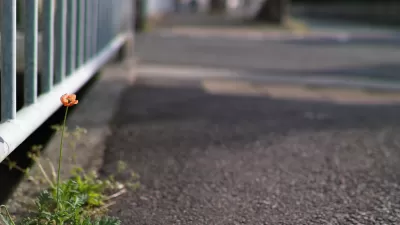Michael J. Coren has a preview of an MIT report that lays out the economic and environmental benefits of stiffer pavement.
It's not much, but roadway asphalt has a springiness to it. As cars roll over asphalt they create indentions about .0003 inches deep. As a result, cars are essentially going up a tiny, yet endless, hill.
"A study by MIT civil engineers found stiffening the nation's pavements could cut fuel use by 3%, the equivalent of 273 million barrels of crude oil, or $15 billion, per year. As a result, CO2 emissions (PDF) would fall by 46.5 million metric tons per year (more than Oregon emits from burning fossil fuels annually)," writes Coren.
The research by Mehdi Akbarian and Franz-Josef Ulm of MIT will appear later this month in the Transportation Research Record. The researchers insist that the cost of replacing roadway surfaces would pay for itself over time. A statement from MIT indicates "...state departments of transportation would save money while reducing their environmental footprint over time, because the roads won't deteriorate as quickly."
Thanks to Jessica Brent
FULL STORY: Stiffer Roads Could Save Billions. That’s Right: Stiffer Roads

Planetizen Federal Action Tracker
A weekly monitor of how Trump’s orders and actions are impacting planners and planning in America.

Restaurant Patios Were a Pandemic Win — Why Were They so Hard to Keep?
Social distancing requirements and changes in travel patterns prompted cities to pilot new uses for street and sidewalk space. Then it got complicated.

Maui's Vacation Rental Debate Turns Ugly
Verbal attacks, misinformation campaigns and fistfights plague a high-stakes debate to convert thousands of vacation rentals into long-term housing.

Boulder Eliminates Parking Minimums Citywide
Officials estimate the cost of building a single underground parking space at up to $100,000.

Orange County, Florida Adopts Largest US “Sprawl Repair” Code
The ‘Orange Code’ seeks to rectify decades of sprawl-inducing, car-oriented development.

Maui's Vacation Rental Debate Turns Ugly
Verbal attacks, misinformation campaigns and fistfights plague a high-stakes debate to convert thousands of vacation rentals into long-term housing.
Urban Design for Planners 1: Software Tools
This six-course series explores essential urban design concepts using open source software and equips planners with the tools they need to participate fully in the urban design process.
Planning for Universal Design
Learn the tools for implementing Universal Design in planning regulations.
Heyer Gruel & Associates PA
JM Goldson LLC
Custer County Colorado
City of Camden Redevelopment Agency
City of Astoria
Transportation Research & Education Center (TREC) at Portland State University
Camden Redevelopment Agency
City of Claremont
Municipality of Princeton (NJ)



























